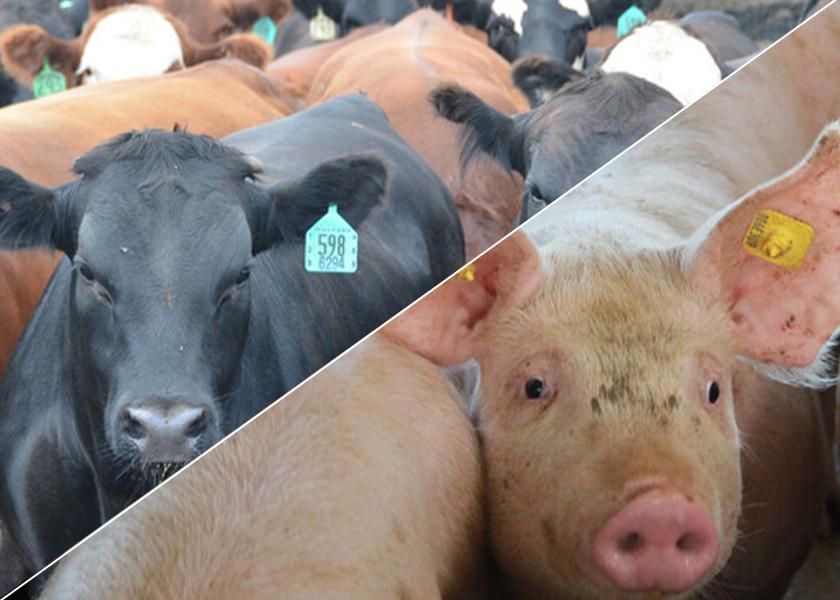Livestock Analysis | August 19, 2022

Price action: October lean hog futures fell 17.5 cents to $93.125, down $6.90 for the week and the contract’s lowest closing price since July 5.
5-day outlook: Hog futures extended a week-long sell-off, sinking to the lowest levels in over six weeks on growing beliefs the cash market has peaked and is heading into a seasonally weak period. Today’s CME lean hog index fell 2 cents to $120.60, the sixth drop in the past seven sessions, and is expected to drop another 31 cents Monday. Based on today’s index, October futures hold an unusually wide discount of over $27 to the benchmark, a strong indication traders see further cash downside. Pork carcass cutout values fell $2.75 early today to $117.16, near a five-week low. Movement was decent at midday at 174 loads.
30-day outlook: Mid-August hog slaughter levels were surprisingly low, suggesting USDA overestimated third-quarter hog supplies. While late-August cash weakness may weigh on lean hog futures in the near term, we still see fourth-quarter hog futures contracts as being undervalued. December lean hogs are presently trading at around a $36 discount to the lean hog index.
90-day outlook: There are fundamental elements that may work in the market bulls’ favor in the next few months. Worries about an impending U.S. economic recession may prompt consumers to purchase cheaper pork cuts over still pricier beef. Domestic consumer demand for red meat has remained fairly strong the past few months. Some studies show that during an economic recession, red meat consumption is not significantly impacted due to consumers eating at home more often and at restaurants less.
What to do: Be prepared to extend feed coverage when market bottoms are in place.
Hedgers: Carry all risk in the cash market for now.
Feed needs: You are hand-to-mouth on corn-for-feed and soybean meal needs.
Price action: October live cattle rose 50 cents to $145.25, up 75 cents for the week. September feeders fell 52.5 cents to $184.75, still up $1.375 for the week.
5-day outlook: The short-term cattle outlook appears bullish, with live steers during the first four days this week averaging $146.76, up about $2.42 from last week. Wholesale beef eased to $264.71 early today but is still above the former all-time high posted prior to the huge surges posted in 2020 and 2021. Beef packers are earning solid margins, so they have incentive to continue bidding actively for fed cattle. Meanwhile, the choice-select spread was quoted at $26.32 today, thereby indicating the supply of market-ready fed cattle remains extremely tight.
USDA’s Cattle on Feed report late today may pressure futures Monday, as July feedlot placements were reported 1.8% above year-earlier levels, compared to expectations for a decline of 1.5%. July had one fewer workday than July 2021, which explains USDA’s marketings figure 4% under year-ago (such a workday reduction often cuts monthly marketings by 4% to 5%). The net result was an August 1 Cattle on Feed figure at 11.224 million head, 1.4% above the same date a year earlier and exceeding expectations for an increase of 0.7%.
30-day outlook: The overall U.S. feedlot population will continue declining seasonally into September. That favors the continuation of the current tightness of market-ready fed cattle supplies, which should prove supportive of fed cattle prices. However, with grilling season largely ending after Labor Day weekend, consumer demand will shift away from steaks and toward cheaper roasts. That may hurt packer margins, as well as overall demand for beef. Thus, a post-Labor Day dip in cash prices can’t be ruled out. Conversely, with consumers over the summer adopting a recession mindset, eating more at home, the cattle market may prove resilient through the end of the year.
90-day outlook: Feedlot placements typically surge to annual highs during fall, but a large proportion of those placed will be calves. Given the long period it will take to feed them to marketable weights (as well as the fact that a large percentage of them will grade select rather than choice), this will not substantially increase the supply of market-ready animals until next spring. There is some concern that sizeable premiums built into deferred futures will encourage producers to slow marketings in hope of grabbing a portion of those higher returns, which in turn could prove problematic for pricing in early 2023, but as long as feedyard managers keep marketings current, the outlook seems conducive to sustained price strength. One potential factor potentially weighing upon the market later in the year could arise from sustained dryness in the Southwest, where being able to feed their cattle could become a major concern for ranchers. That could force a wave of cattle out of pastures and into feedlots (calves and yearlings) or to the packing house (cows and bulls).
What to do: Be prepared to extend feed coverage when market bottoms are in place.
Hedgers: Carry all risk in the cash market for now.
Feed needs: You are hand-to-mouth on corn-for-feed and soybean meal needs.






